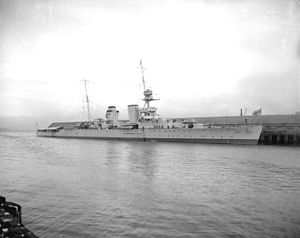
| |
| Class overview | |
|---|---|
| Name | Hawkins class |
| Operators | |
| Preceded by | Town class |
| Succeeded by | County class |
| Built | 1916–1925 |
| In commission | 1919–1947 |
| Completed | 5 |
| Lost | 2 |
| Scrapped | 3 |
| General characteristics | |
| Type | Heavy cruiser |
| Displacement | |
| Length | 605 ft (184.4 m)(o/a) |
| Beam | 65 ft (19.8 m) |
| Draught | 19 ft 3 in (5.9 m) (deep load) |
| Installed power |
|
| Propulsion | 4 shafts; 4 × geared steam turbine sets |
| Speed | 30–31 knots (56–57 km/h; 35–36 mph) |
| Range | 5,640 nmi (10,450 km; 6,490 mi) at 10 knots (19 km/h; 12 mph) |
| Complement | 709 |
| Armament |
|
| Armour |
|
| General characteristics (Vindictive) | |
| Type | Aircraft carrier |
| Displacement | 9,996 long tons (10,156 t) (standard) |
| Installed power | 12 Yarrow boilers; 60,000 shp |
| Speed | 30 knots (56 km/h; 35 mph) |
| Armament |
|
| Aircraft carried | 6–12 aircraft |
The Hawkins class consisted of five heavy cruisers built for the Royal Navy during the First World War, although none of them saw service during the war. The first ship to be completed, HMS Vindictive, was renamed from HMS Cavendish and converted into an aircraft carrier while under construction. All ships were named after Elizabethan sea captains. The three ships remaining as cruisers in 1939 served in the Second World War, with Effingham being an early war loss through wreck; Raleigh had been lost in a similar shipwreck on uncharted rocks in 1922 (and Vindictive was nearly lost to grounding in 1919). Vindictive, though no longer a cruiser, also served throughout the War. This class formed the basis for the definition of the maximum cruiser type under the Washington Naval Treaty of 1922.